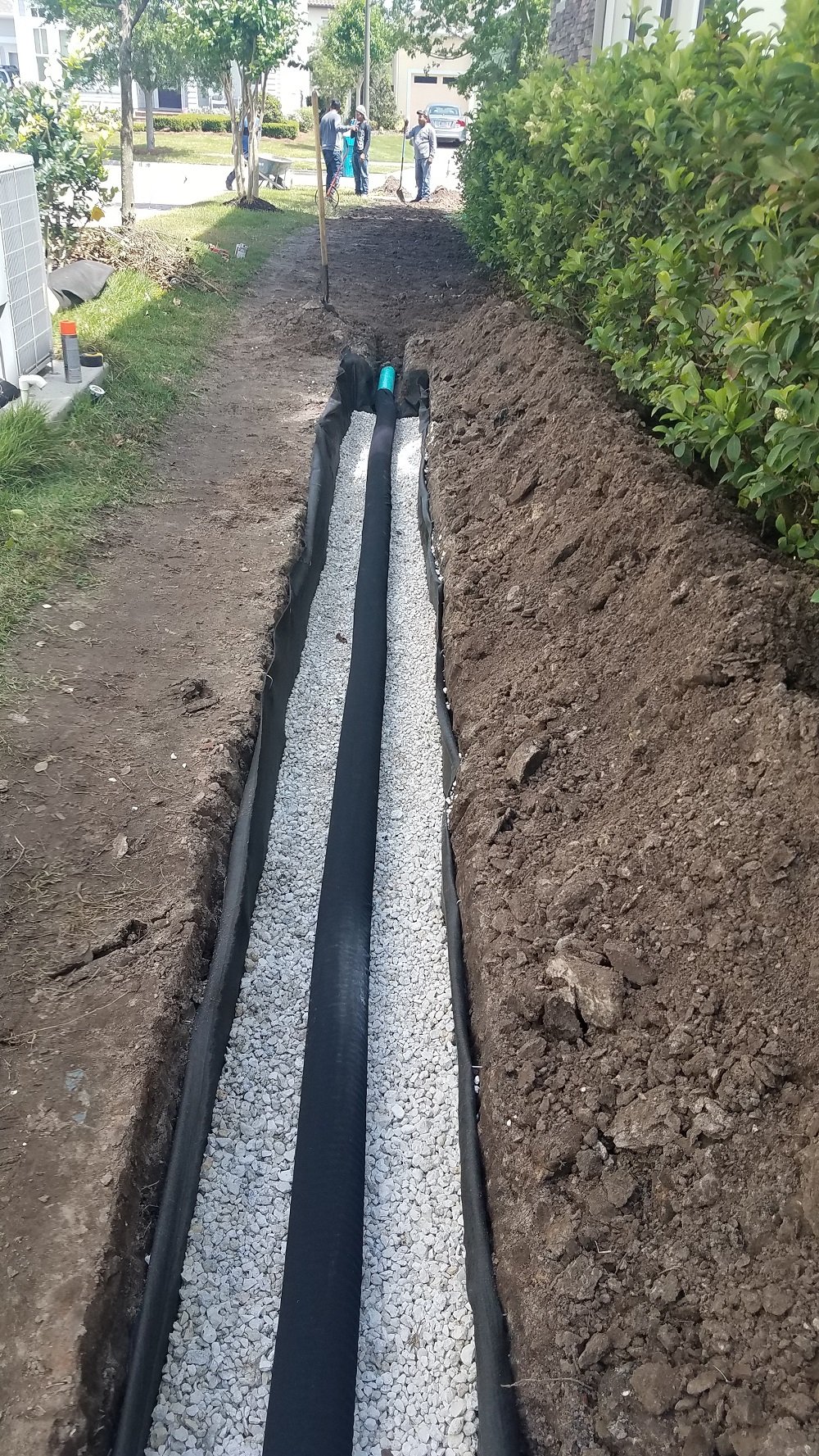The Essential Guide to Preserving Your French Drainpipe for Lasting Performance
Maintaining your French drain is key to its performance and your property's defense. Normal checks can conserve you from expensive repair services and water damages. You'll wish to know what indications to search for and how frequently to examine your system. Plus, recognizing the cleansing process can make a significant difference. Allow's discover the necessary steps for ensuring your drain operates well for many years to find.
Comprehending the Function of a French Drain
A French drainpipe is a critical element in taking care of water around your home. It guides excess water away from your foundation, preventing flooding and damage. When hefty rainfall falls, the drainpipe accumulates water through a perforated pipeline buried in gravel. This system enables water to flow openly, lowering pressure on your cellar walls and minimizing the threat of leaks.You could wonder how it functions in practice. As water fills the soil, gravity pulls it toward the drainpipe. The perforated pipeline catches this water, transferring it to a designated water drainage area or storm drain. This procedure keeps your lawn dry and shields your home's architectural integrity.Understanding just how a French drain functions is vital to appreciating its value. By successfully directing water away, it assists maintain a safe and completely dry living setting. So, keeping your French drainpipe in top condition warranties you avoid expensive repair services down the line.
Regular Inspections: What to Try to find
Start by inspecting for any type of obstructions that could be blocking water circulation when you're examining your French drain. Pay focus to signs of surface erosion around the drain, as this can show prospective concerns. Routine analyses will help keep your water drainage system operating efficiently.
Blocked Drainpipe Assessment
Exactly how can you tell if your French drain is clogged? Watch for water merging in your yard, especially after heavy rain. If you observe areas where water gathers rather than draining, that's a red flag. You must additionally examine the drainpipe electrical outlet; if water isn't spurting as it should, there's likely a blockage. Listen for unusual gurgling audios, which can show trapped air. Furthermore, check the drain's surface for any vegetation development, as roots can infiltrate and clog the system. Lastly, if you smell musty smells, it might indicate stagnant water caused by an obstruction. Consistently examining these indications can help you keep your French drain successfully and stop expensive repair work.
Surface Area Erosion Examine

Cleansing Your French Drainpipe: Step-by-Step Guide
Cleansing your French drainpipe is crucial for keeping it working appropriately. You'll require some certain tools and a clear procedure to ensure whatever runs efficiently. Let's walk with the actions and pointers for maintaining your drain properly.
Devices You'll Require
To tackle the job of cleaning your French drain successfully, you'll wish to gather a couple of necessary tools. Grab a durable set of gloves to shield your hands from particles and sharp items. A little shovel or trowel will help you eliminate dust or obstructions around the drain. For removing the interior, a plumbing professional's serpent or a high-pressure water nozzle can be unbelievably valuable. You'll additionally require a pail for collecting any type of particles you take out. Finally, having a garden tube handy will certainly make it less complicated to wash out the drain and ensure it's streaming smoothly. With these devices all set, you'll be set for a detailed cleaning session!
Cleansing Process Actions
Beginning by reviewing the area around your French drain for any type of visible debris or blockages. Get rid of fallen leaves, branches, or dirt that might block water circulation. Next off, inspect the inlet and electrical outlet areas; clear any kind of blockages to ensure appropriate water drainage. Utilize a yard tube to purge the drainpipe, routing water into the inlet. This helps displace any kind of built up sludge or debris. Consider using a plumbing technician's serpent to damage them up if you see persistent obstructions. After cleansing, examine the gravel around the drain; restore it if it's removed. Validate the drainpipe covers are undamaged and securely in place to prevent debris from entering. Routine cleaning keeps your French drainpipe operating effectively.
Upkeep Regularity Tips
While routine maintenance is necessary for your French drain's longevity, understanding exactly how commonly to preserve it can make all the distinction. Ideally, you need to check your French drain at the very least twice a year, preferably in spring and loss. After heavy rainfall or snowmelt, look for clogs or debris. If you see any standing water, it's time to cleanse your drain.In areas with hefty vegetation, even more regular upkeep-- concerning every three months-- may be necessary. Furthermore, think about cleansing your French drain after major storms or if you observe water pooling in your backyard. By remaining positive, you'll assure your French drainpipe functions effectively and shields your building from water damages. Routine checks will you could try here certainly save you money and time over time.
Recognizing Typical Issues and Their Solutions
It's vital to determine common concerns with your French drainpipe and carry out efficient remedies when you notice water pooling in your backyard or damp areas in your cellar. One regular problem is blocking, commonly triggered by particles like fallen leaves or debris. To fix this, you can make use of a pipes snake or a high-pressure water jet to clear blockages.Another concern could be incorrect slope. If your drainpipe isn't sloped correctly, water won't flow far from your home. You can change the slope by excavating and rearranging the drain pipe.Lastly, look for damages or cracks in the drain itself. Replacing the harmed sections is vital for peak efficiency if you locate any. By resolving these concerns promptly, you'll help guarantee that your click over here now French drain remains to function successfully, shielding your home from water damage and maintaining a dry, secure environment.
Seasonal Maintenance Tips for Your French Drainpipe
Attending to usual concerns with your French drainpipe is just the primary step in guaranteeing its long-term efficiency. Seasonal upkeep is essential for peak performance. In the spring, eliminate leaves and particles that might have gathered during winter. Check for any kind of obstructions in the electrical outlet or capture basin, as water needs a clear course to move freely.During summer, check your drainpipe for any kind of indicators of shifting or working out dirt. Make sure it's still level and operating properly. As loss strategies, clean any fallen entrusts to protect against clogs before winter season arrives.In wintertime, expect freezing temperatures. Make certain your drainpipe isn't at threat of cold if you live in a cool environment. Shielding revealed pipelines can assist. Routine checks and timely maintenance can prevent costly repairs and keep your French drainpipe working successfully year-round. Stay proactive and take pleasure in tranquility of mind understanding your drain system is in good condition!
When to Hire an Expert
When to call in a specialist can conserve you time and avoid further damages to your French drainpipe, understanding. If you see relentless standing water in your lawn, it's a clear sign that your drainpipe might be clogged or harmed. Don't ignore weird odors, as they can indicate sewer backup or degeneration, which calls for prompt attention.If you discover that your drain isn't operating appropriately after attempts to tidy or preserve it, it's time to connect for professional aid. Additionally, if you're unclear regarding the underlying issues or do not have the necessary devices, employing a specialist can offer tranquility of mind.Finally, if your French drainpipe is old or has actually experienced considerable deterioration, professional assessment can determine whether repairs or full substitute is needed. Trust the professionals to assure your drainage system functions successfully for many company website years to find.
Tips for Avoiding Future Drain Problems
To keep your French drainpipe operating efficiently, consistently examining and keeping it can make all the difference. Begin by getting rid of particles, leaves, and dust from the surface area and drainpipe openings. This avoids obstructions that can bring about water back-up. Examine the gravel around the drain; if it's compressed or eroded, take into consideration adding fresh crushed rock to preserve excellent flow.Next, divert water far from your drainpipe by guaranteeing seamless gutters and downspouts are clear and guiding water a minimum of 3 feet far from your structure. Routinely inspect for any type of indications of damages or drooping. If you see issues, address them immediately.Finally, consider setting up a catch or a filter container to catch bigger particles prior to it gets in the drainpipe. By remaining aggressive with these pointers, you'll decrease the threat of future drainage troubles and maintain your French drainpipe in leading form.
Frequently Asked Concerns
Exactly how Lengthy Does a French Drainpipe Normally Last?
A French drainpipe normally lasts around 30 to 40 years, depending upon the materials utilized and maintenance (Portland French Drain). If you stay on top of regular checks, you can expand its life-span also further
Can I Install a French Drainpipe Myself?
Yes, you can set up a French drain yourself if you've obtained the right devices and expertise. Simply ensure to prepare very carefully, comply with local regulations, and guarantee correct water drainage to prevent future issues.
What Products Are Made Use Of in a French Drainpipe?
You'll require perforated pipe, gravel, landscape textile, and a strong drainage pipeline for your French drain. These products assist redirect water successfully, stopping flooding and keeping your property completely dry and safe from water damage.

Is an Authorization Required to Mount a French Drain?
You'll likely need a license to mount a French drainpipe, depending on regional guidelines. Talk to your municipality to guarantee you follow any necessary standards and stay clear of possible problems during installation.
What Are the Expenses Related To French Drain Upkeep?
Keeping a French drainpipe typically sets you back in between $100 and $500 every year. You'll need to take into account expenses for cleansing, fixings, and assessments. Routine maintenance helps stop bigger expenses and warranties your system works correctly for many years - Portland French Drain. When you're inspecting your French drain, start by examining for any type of clogs that could be obstructing water flow. By remaining proactive, you'll assure your French drain features properly and shields your property from water damages. When you notice water merging in your yard or damp areas in your basement, it's crucial to determine common problems with your French drain and carry out effective options. You can change the slope by excavating and repositioning the drainpipe pipe.Lastly, check for damage or fractures in the drainpipe itself. Check the crushed rock around the drain; if it's compressed or deteriorated, think about including fresh gravel to preserve ideal flow.Next, divert water away from your drainpipe by making sure downspouts and rain gutters are clear and routing water at least three feet away from your structure